2022年英语中考语法系列课件时态专题02(过将现进过进现完过完)共 22张PPT
文档属性
| 名称 | 2022年英语中考语法系列课件时态专题02(过将现进过进现完过完)共 22张PPT |  | |
| 格式 | zip | ||
| 文件大小 | 362.4KB | ||
| 资源类型 | 教案 | ||
| 版本资源 | 通用版 | ||
| 科目 | 英语 | ||
| 更新时间 | 2021-08-01 22:09:34 | ||
图片预览

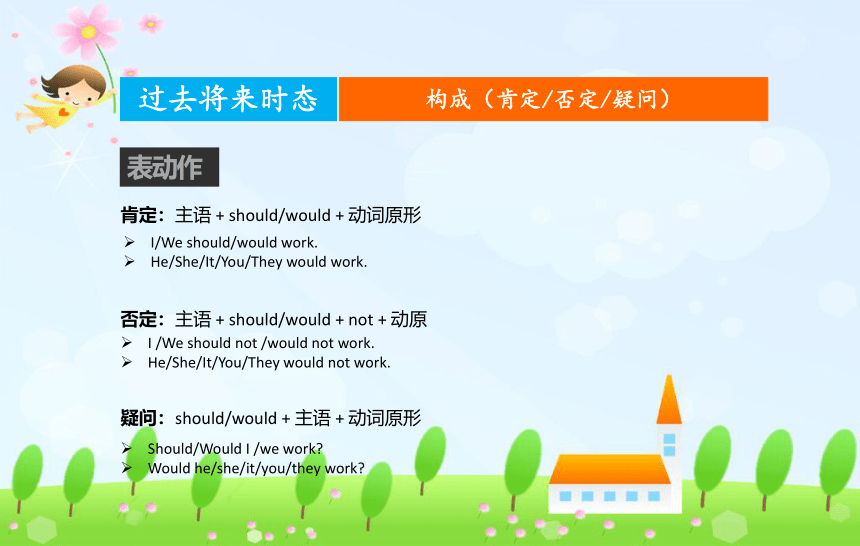
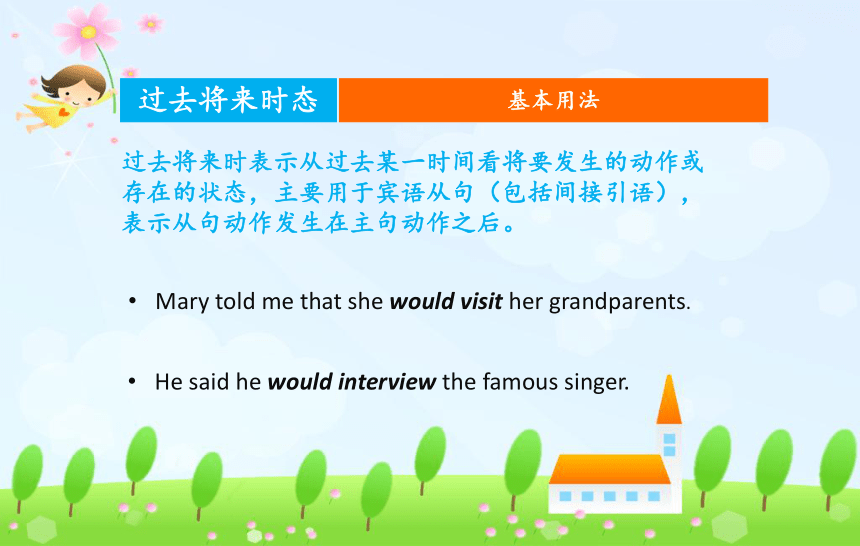
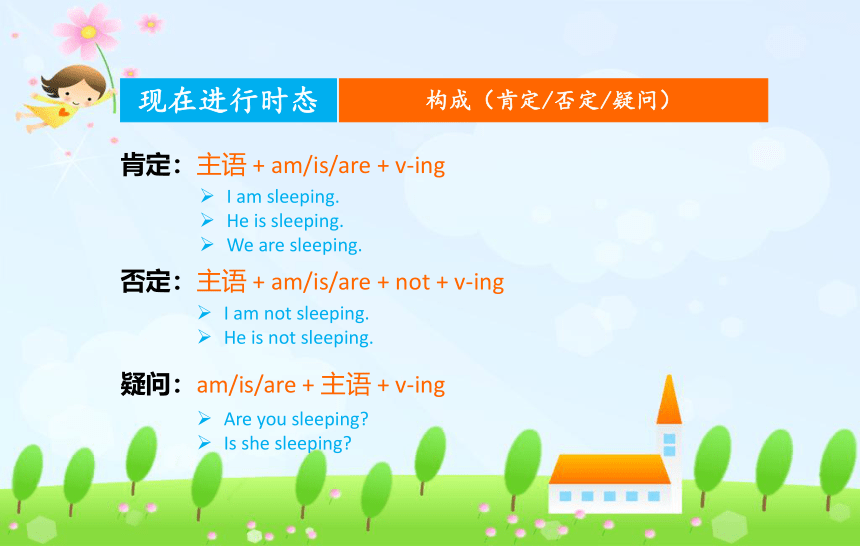
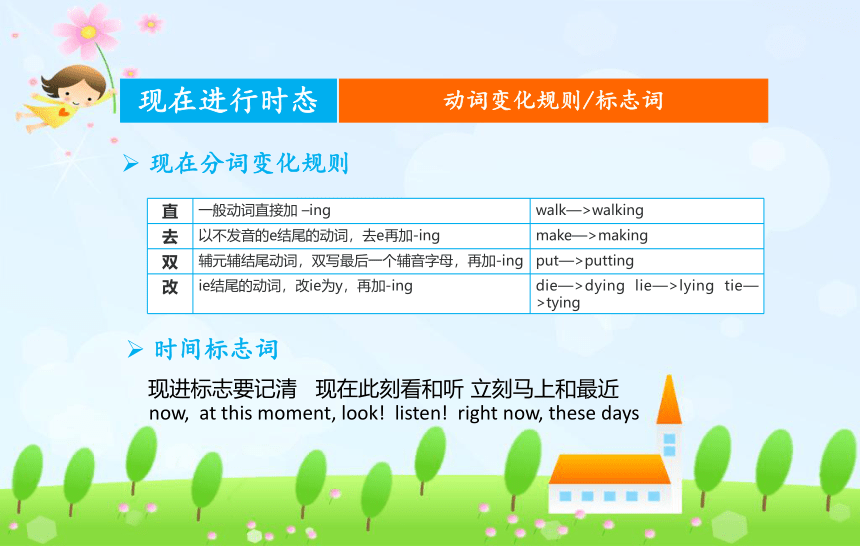

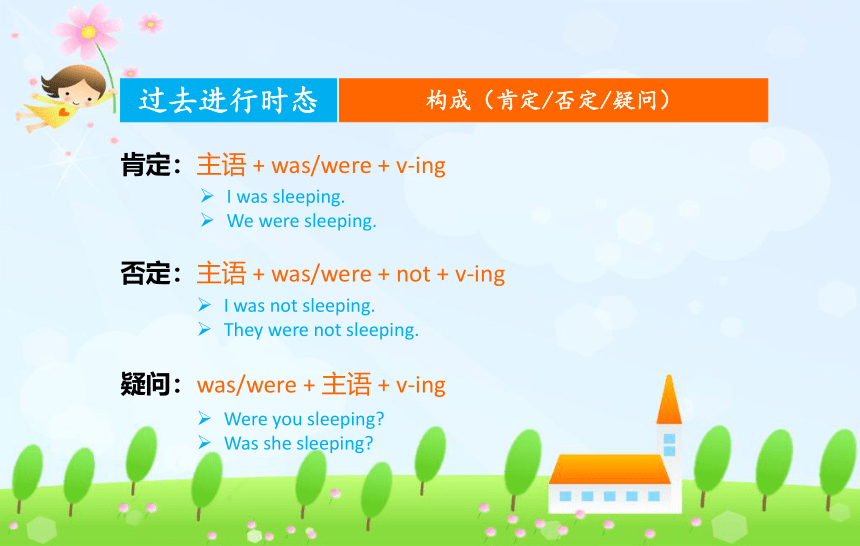
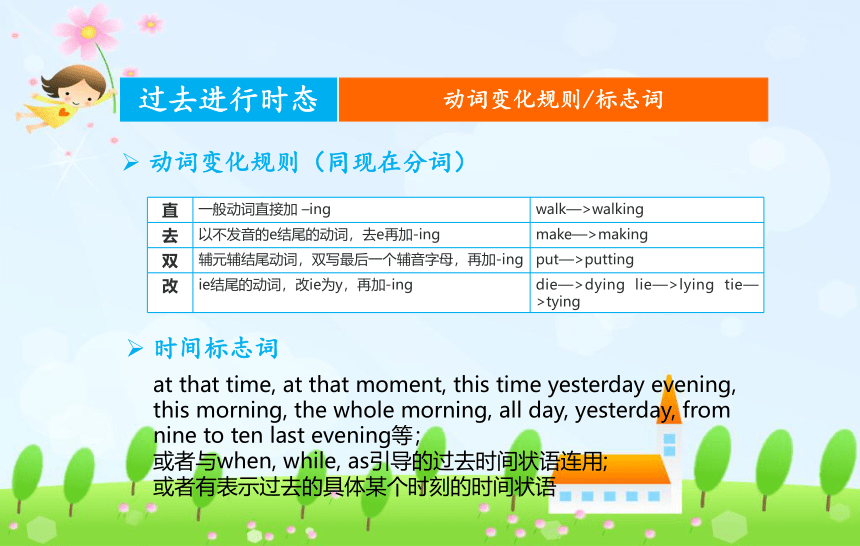

文档简介
(共21张PPT)
时态(二)
过将+现进+过进+现完+过完
构成(肯定/否定/疑问)
过去将来时态
Should/Would
I
/we
work?
Would
he/she/it/you/they
work?
肯定:主语
+
should/would
+
动词原形
I/We
should/would
work.
He/She/It/You/They
would
work.
否定:主语
+
should/would
+
not
+
动原
疑问:should/would
+
主语
+
动词原形
I
/We
should
not
/would
not
work.
He/She/It/You/They
would
not
work.
表动作
基本用法
过去将来时态
Mary
told
me
that
she
would
visit
her
grandparents.
过去将来时表示从过去某一时间看将要发生的动作或存在的状态,主要用于宾语从句(包括间接引语),表示从句动作发生在主句动作之后。
He
said
he
would
interview
the
famous
singer.
构成(肯定/否定/疑问)
现在进行时态
Are
you
sleeping?
Is
she
sleeping?
肯定:主语
+
am/is/are
+
v-ing
I
am
sleeping.
He
is
sleeping.
We
are
sleeping.
否定:主语
+
am/is/are
+
not
+
v-ing
疑问:am/is/are
+
主语
+
v-ing
I
am
not
sleeping.
He
is
not
sleeping.
动词变化规则/标志词
现在进行时态
now,
at
this
moment,
look!
listen!
right
now,
these
days
现在分词变化规则
时间标志词
直
一般动词直接加
–ing
walk—>walking
去
以不发音的e结尾的动词,去e再加-ing
make—>making
双
辅元辅结尾动词,双写最后一个辅音字母,再加-ing
put—>putting
改
ie结尾的动词,改ie为y,再加-ing
die—>dying
lie—>lying
tie—>tying
现进标志要记清
现在此刻看和听
立刻马上和最近
基本用法
现在进行时态
Who
are
you
waiting
for?
We
are
talking
about
you
now.
①
表示说话时谓语的动作正在进行
The
students
are
working
on
the
farm
these
days.
②
表现阶段正在进行,但说话时动作不一定正在进行
Mary
is
arriving
here
at
4
o’clock
this
afternoon.
③
有些动词可进行时表将来(已确定或安排好的将来)
这类动词有go,
come,
leave,
arrive,
move,
die等
He
is
always
asking
questions.
④
与always等副词连用,表赞扬讨厌等主观色彩
1)表示状态或感觉词,如:know,
love,
like,
want,
hear,
see,
think等,一般没有进行时态
2)非延续性动词,如:jump,
begin,
start,
stop等一般不宜用于进行时态
构成(肯定/否定/疑问)
过去进行时态
Were
you
sleeping?
Was
she
sleeping?
肯定:主语
+
was/were
+
v-ing
I
was
sleeping.
We
were
sleeping.
否定:主语
+
was/were
+
not
+
v-ing
疑问:was/were
+
主语
+
v-ing
I
was
not
sleeping.
They
were
not
sleeping.
动词变化规则/标志词
过去进行时态
动词变化规则(同现在分词)
时间标志词
at
that
time,
at
that
moment,
this
time
yesterday
evening,
this
morning,
the
whole
morning,
all
day,
yesterday,
from
nine
to
ten
last
evening等;
或者与when,
while,
as引导的过去时间状语连用;
或者有表示过去的具体某个时刻的时间状语
直
一般动词直接加
–ing
walk—>walking
去
以不发音的e结尾的动词,去e再加-ing
make—>making
双
辅元辅结尾动词,双写最后一个辅音字母,再加-ing
put—>putting
改
ie结尾的动词,改ie为y,再加-ing
die—>dying
lie—>lying
tie—>tying
基本用法
过去进行时态
He
was
having
breakfast
at
6:30
yesterday
morning.
①
表示过去某个精确时间正在进行的动作
He
was
writing
a
book
last
year.
②
表示过去某段时间正在进行的动作
构成(肯定/否定/疑问)
现在完成时态
Have
you
had
lunch?
肯定:主语
+
have/has
+
done(过去分词)
I
have
had
lunch.
否定:主语
+
have/has
+
not
+
done(过去分词)
疑问:Have/Has
+
主语
+
done(过去分词)?
I
have
not
had
lunch.
She
has
had
lunch.
I
has
not
had
lunch.
Has
she
had
lunch?
动词变化规则/标志词
现在完成时态
过去分词变化规则
判断标志词
直
一般动词直接加
–ed
want—>wanted
own—>owned
去
以不发音的e结尾的动词,去e再加-ed
like—>liked
continue—>continued
双
辅元辅结尾动词,双写最后一个辅音字母,再加-ed
stop—>stopped
改
以辅音加y结尾的动词,改y为i,再加-ed
study—>studied
动词过去加ed,直去双改请牢记(和过去式变化相同)
不规则变化(有些和过去式相同,有些不同)
①
since+时间点,for+时间段
,in
the
past/last
few
days
(months,
years…)
②
already(肯定句),
yet(否定,疑问句),ever,
never,
twice(once…),
so
far(到目前为止),
before(以前),
recently(近来)
等词连用
③
表示瞬间动作的词,如:come,go,die,marry,buy等的完成时不能与for,since等表示一段时间的词连用。
基本用法
现在完成时态
She
has
been
ill
for
three
days,
that’s
why
he
isn’t
here
today.
①
表过去某时间发生的动作或存在的状态,对现在仍有影响
We
have
known
each
other
since
we
were
children.
②
表从过去某时间开始一直持续到现在的动作或状态
He
has
already
left,
so
you
cannot
meet
him
now.
I
have
studied
English
for
5
years.
瞬间动词和延续动词转化
现在完成时态
1、die→be
dead
2、buy→have
3、finish
/
end→be
over
4、begin
/
start→be
on
5、open→be
open
6、close→be
closed
7、borrow
/
lend→keep
8、arrive
/come
/
go→be
in
/at
/
be
here
/be
there
9、leave→be
away(from)
10、become→be
11、catch
/
get
a
cold→have
a
cold
12、fall
asleep→be
asleep
13、join
the
army→be
in
the
army
/be
a
soldier
14、join→be
in
/
be
a…member
of
15、return
/
come
back
/
get
back→be
back
The
ghost
has
died,
so
you
don’t
have
to
worry
about
it.
The
ghost
has
been
dead
for
3
days,
so
you
don’t
have
to
worry
about
it.
have
been
to,
have
gone
to,
have
been
in
区别
现在完成时态
His
parents
have
been
in
China
for
three
months.
I
have
been
here
for
two
hours.
She
has
been
a
teacher
for
five
years.
①
have
been
in意为“在某地呆了多长时间”
;have
been意为“成为……多长时间”;
He
has
just
been
to
the
library.
They
have
never
been
to
the
Great
Wall.
I
have
been
to
Beijing
many
times.
②
have
been
to意为“曾经去过某地”
Where
is
Tom?
He
has
gone
to
the
post
office.
Mr
Green
isn’t
here.
He
has
gone
to
Shanghai..
③
have
gone
to意为“到某地去了”,
说话时不在现场
构成(肯定/否定/疑问)
过去完成时态
Had
you
finished
lunch
when
I
called
you?
肯定:主语
+
had
+
done(过去分词)
The
bus
had
left
when
I
arrived
at
the
bus
stop.
否定:主语
+
had
+
not
+
done(过去分词)
疑问:Had+
主语
+
done(过去分词)?
He
had
not
finished
the
work
when
I
arrived.
动词变化规则/标志词
过去完成时态
过去分词变化规则
时间标志词
直
一般动词直接加
–ed
want—>wanted
own—>owned
去
以不发音的e结尾的动词,去e再加-ed
like—>liked
continue—>continued
双
辅元辅结尾动词,双写最后一个辅音字母,再加-ed
stop—>stopped
改
以辅音加y结尾的动词,改y为i,再加-ed
study—>studied
动词过去加ed,直去双改请牢记
不规则变化(有些和过去式相同,有些不同)
…before,
by,
until,
when等引导的过去时间状语
基本用法
过去完成时态
I
had
lived
in
Shenzhen
by
yesterday.
(过去某时间前)
过去完成时表示过去某一时间以前或过去某一动作以前已完成的动作,即过去的过去。
He
had
finished
his
work
before
he
came
here.(过去动作前)
基本用法
现在完成进行时态
I
have
been
living
here
for
8
years.
我在这儿生活八年了。
①
表“持续”:
某个动作或状态持续到现在或将来
We
have
been
seeing
each
other
quite
often
recently.
最近我们经常见面。
②
表“重复”
:在一段持续的时间内动作的多次重复
She
has
been
calling
me
several
times
this
week.
③
表示一定的感彩,如厌恶指责等
They
are
very
tired.
They
have
been
working
hard.
他们很劳累。他们一直在努力工作。
I
have
been
going
to
the
hospital
this
month.
我这个月总是往医院跑。
一般过去
VS
现在完成
I
have
studied
English
for
3
years.
①
一般过去只表示过去的动作或状态,
不强调对现在的影响
I
studied
English.
现在完成表示过去的动作或状态一直延续,或强调对现在的影响
I
have
studied
English
since
3
years
ago.
②
一般过去常与具体的表示过去的时间状语连用
I
studied
English
3
years
ago.
现在完成常与现在完成时相关的时间状语连用
I
have
studied
English
for
3
years.
一般过去
VS
过去完成
I
had
studied
English
before
I
went
to
America.
①
一般过去表示以现在为参照点的过去
I
studied
English.
过去完成表示以过去为参照点的过去,即过去的过去
I
studied
English
3
years
ago.
②
一般过去常与具体的表示过去的时间状语连用
过去完成时间状语常用by和before引导,如by
that
time,
by
the
end
of,
before
2000,
by
the
time
等
I
had
studied
English
for
3
years
by
2010.
I
had
studied
English
before
2010.
现在
过去的过去
过去
现在完成
VS
过去完成
I
had
studied
English
for
10
years
when
I
met
him.
①
现在完成表示的是延续到现在或同现在有关的动作
I
have
studied
English
for
10
years.
过去完成表示在过去某时之前已经完成或延续到过去某时的动作
I
have
studied
English
since
3
years
ago.
②
现在完成常与现在完成相关的时间状语连用
since,
for,
already…
过去完成常与过去完成相关的时间状语连用
by,
before,
when…
I
had
studied
English
for
3
years
before
2014.
时态(二)
过将+现进+过进+现完+过完
构成(肯定/否定/疑问)
过去将来时态
Should/Would
I
/we
work?
Would
he/she/it/you/they
work?
肯定:主语
+
should/would
+
动词原形
I/We
should/would
work.
He/She/It/You/They
would
work.
否定:主语
+
should/would
+
not
+
动原
疑问:should/would
+
主语
+
动词原形
I
/We
should
not
/would
not
work.
He/She/It/You/They
would
not
work.
表动作
基本用法
过去将来时态
Mary
told
me
that
she
would
visit
her
grandparents.
过去将来时表示从过去某一时间看将要发生的动作或存在的状态,主要用于宾语从句(包括间接引语),表示从句动作发生在主句动作之后。
He
said
he
would
interview
the
famous
singer.
构成(肯定/否定/疑问)
现在进行时态
Are
you
sleeping?
Is
she
sleeping?
肯定:主语
+
am/is/are
+
v-ing
I
am
sleeping.
He
is
sleeping.
We
are
sleeping.
否定:主语
+
am/is/are
+
not
+
v-ing
疑问:am/is/are
+
主语
+
v-ing
I
am
not
sleeping.
He
is
not
sleeping.
动词变化规则/标志词
现在进行时态
now,
at
this
moment,
look!
listen!
right
now,
these
days
现在分词变化规则
时间标志词
直
一般动词直接加
–ing
walk—>walking
去
以不发音的e结尾的动词,去e再加-ing
make—>making
双
辅元辅结尾动词,双写最后一个辅音字母,再加-ing
put—>putting
改
ie结尾的动词,改ie为y,再加-ing
die—>dying
lie—>lying
tie—>tying
现进标志要记清
现在此刻看和听
立刻马上和最近
基本用法
现在进行时态
Who
are
you
waiting
for?
We
are
talking
about
you
now.
①
表示说话时谓语的动作正在进行
The
students
are
working
on
the
farm
these
days.
②
表现阶段正在进行,但说话时动作不一定正在进行
Mary
is
arriving
here
at
4
o’clock
this
afternoon.
③
有些动词可进行时表将来(已确定或安排好的将来)
这类动词有go,
come,
leave,
arrive,
move,
die等
He
is
always
asking
questions.
④
与always等副词连用,表赞扬讨厌等主观色彩
1)表示状态或感觉词,如:know,
love,
like,
want,
hear,
see,
think等,一般没有进行时态
2)非延续性动词,如:jump,
begin,
start,
stop等一般不宜用于进行时态
构成(肯定/否定/疑问)
过去进行时态
Were
you
sleeping?
Was
she
sleeping?
肯定:主语
+
was/were
+
v-ing
I
was
sleeping.
We
were
sleeping.
否定:主语
+
was/were
+
not
+
v-ing
疑问:was/were
+
主语
+
v-ing
I
was
not
sleeping.
They
were
not
sleeping.
动词变化规则/标志词
过去进行时态
动词变化规则(同现在分词)
时间标志词
at
that
time,
at
that
moment,
this
time
yesterday
evening,
this
morning,
the
whole
morning,
all
day,
yesterday,
from
nine
to
ten
last
evening等;
或者与when,
while,
as引导的过去时间状语连用;
或者有表示过去的具体某个时刻的时间状语
直
一般动词直接加
–ing
walk—>walking
去
以不发音的e结尾的动词,去e再加-ing
make—>making
双
辅元辅结尾动词,双写最后一个辅音字母,再加-ing
put—>putting
改
ie结尾的动词,改ie为y,再加-ing
die—>dying
lie—>lying
tie—>tying
基本用法
过去进行时态
He
was
having
breakfast
at
6:30
yesterday
morning.
①
表示过去某个精确时间正在进行的动作
He
was
writing
a
book
last
year.
②
表示过去某段时间正在进行的动作
构成(肯定/否定/疑问)
现在完成时态
Have
you
had
lunch?
肯定:主语
+
have/has
+
done(过去分词)
I
have
had
lunch.
否定:主语
+
have/has
+
not
+
done(过去分词)
疑问:Have/Has
+
主语
+
done(过去分词)?
I
have
not
had
lunch.
She
has
had
lunch.
I
has
not
had
lunch.
Has
she
had
lunch?
动词变化规则/标志词
现在完成时态
过去分词变化规则
判断标志词
直
一般动词直接加
–ed
want—>wanted
own—>owned
去
以不发音的e结尾的动词,去e再加-ed
like—>liked
continue—>continued
双
辅元辅结尾动词,双写最后一个辅音字母,再加-ed
stop—>stopped
改
以辅音加y结尾的动词,改y为i,再加-ed
study—>studied
动词过去加ed,直去双改请牢记(和过去式变化相同)
不规则变化(有些和过去式相同,有些不同)
①
since+时间点,for+时间段
,in
the
past/last
few
days
(months,
years…)
②
already(肯定句),
yet(否定,疑问句),ever,
never,
twice(once…),
so
far(到目前为止),
before(以前),
recently(近来)
等词连用
③
表示瞬间动作的词,如:come,go,die,marry,buy等的完成时不能与for,since等表示一段时间的词连用。
基本用法
现在完成时态
She
has
been
ill
for
three
days,
that’s
why
he
isn’t
here
today.
①
表过去某时间发生的动作或存在的状态,对现在仍有影响
We
have
known
each
other
since
we
were
children.
②
表从过去某时间开始一直持续到现在的动作或状态
He
has
already
left,
so
you
cannot
meet
him
now.
I
have
studied
English
for
5
years.
瞬间动词和延续动词转化
现在完成时态
1、die→be
dead
2、buy→have
3、finish
/
end→be
over
4、begin
/
start→be
on
5、open→be
open
6、close→be
closed
7、borrow
/
lend→keep
8、arrive
/come
/
go→be
in
/at
/
be
here
/be
there
9、leave→be
away(from)
10、become→be
11、catch
/
get
a
cold→have
a
cold
12、fall
asleep→be
asleep
13、join
the
army→be
in
the
army
/be
a
soldier
14、join→be
in
/
be
a…member
of
15、return
/
come
back
/
get
back→be
back
The
ghost
has
died,
so
you
don’t
have
to
worry
about
it.
The
ghost
has
been
dead
for
3
days,
so
you
don’t
have
to
worry
about
it.
have
been
to,
have
gone
to,
have
been
in
区别
现在完成时态
His
parents
have
been
in
China
for
three
months.
I
have
been
here
for
two
hours.
She
has
been
a
teacher
for
five
years.
①
have
been
in意为“在某地呆了多长时间”
;have
been意为“成为……多长时间”;
He
has
just
been
to
the
library.
They
have
never
been
to
the
Great
Wall.
I
have
been
to
Beijing
many
times.
②
have
been
to意为“曾经去过某地”
Where
is
Tom?
He
has
gone
to
the
post
office.
Mr
Green
isn’t
here.
He
has
gone
to
Shanghai..
③
have
gone
to意为“到某地去了”,
说话时不在现场
构成(肯定/否定/疑问)
过去完成时态
Had
you
finished
lunch
when
I
called
you?
肯定:主语
+
had
+
done(过去分词)
The
bus
had
left
when
I
arrived
at
the
bus
stop.
否定:主语
+
had
+
not
+
done(过去分词)
疑问:Had+
主语
+
done(过去分词)?
He
had
not
finished
the
work
when
I
arrived.
动词变化规则/标志词
过去完成时态
过去分词变化规则
时间标志词
直
一般动词直接加
–ed
want—>wanted
own—>owned
去
以不发音的e结尾的动词,去e再加-ed
like—>liked
continue—>continued
双
辅元辅结尾动词,双写最后一个辅音字母,再加-ed
stop—>stopped
改
以辅音加y结尾的动词,改y为i,再加-ed
study—>studied
动词过去加ed,直去双改请牢记
不规则变化(有些和过去式相同,有些不同)
…before,
by,
until,
when等引导的过去时间状语
基本用法
过去完成时态
I
had
lived
in
Shenzhen
by
yesterday.
(过去某时间前)
过去完成时表示过去某一时间以前或过去某一动作以前已完成的动作,即过去的过去。
He
had
finished
his
work
before
he
came
here.(过去动作前)
基本用法
现在完成进行时态
I
have
been
living
here
for
8
years.
我在这儿生活八年了。
①
表“持续”:
某个动作或状态持续到现在或将来
We
have
been
seeing
each
other
quite
often
recently.
最近我们经常见面。
②
表“重复”
:在一段持续的时间内动作的多次重复
She
has
been
calling
me
several
times
this
week.
③
表示一定的感彩,如厌恶指责等
They
are
very
tired.
They
have
been
working
hard.
他们很劳累。他们一直在努力工作。
I
have
been
going
to
the
hospital
this
month.
我这个月总是往医院跑。
一般过去
VS
现在完成
I
have
studied
English
for
3
years.
①
一般过去只表示过去的动作或状态,
不强调对现在的影响
I
studied
English.
现在完成表示过去的动作或状态一直延续,或强调对现在的影响
I
have
studied
English
since
3
years
ago.
②
一般过去常与具体的表示过去的时间状语连用
I
studied
English
3
years
ago.
现在完成常与现在完成时相关的时间状语连用
I
have
studied
English
for
3
years.
一般过去
VS
过去完成
I
had
studied
English
before
I
went
to
America.
①
一般过去表示以现在为参照点的过去
I
studied
English.
过去完成表示以过去为参照点的过去,即过去的过去
I
studied
English
3
years
ago.
②
一般过去常与具体的表示过去的时间状语连用
过去完成时间状语常用by和before引导,如by
that
time,
by
the
end
of,
before
2000,
by
the
time
等
I
had
studied
English
for
3
years
by
2010.
I
had
studied
English
before
2010.
现在
过去的过去
过去
现在完成
VS
过去完成
I
had
studied
English
for
10
years
when
I
met
him.
①
现在完成表示的是延续到现在或同现在有关的动作
I
have
studied
English
for
10
years.
过去完成表示在过去某时之前已经完成或延续到过去某时的动作
I
have
studied
English
since
3
years
ago.
②
现在完成常与现在完成相关的时间状语连用
since,
for,
already…
过去完成常与过去完成相关的时间状语连用
by,
before,
when…
I
had
studied
English
for
3
years
before
2014.
同课章节目录
- 词法
- 名词
- 动词和动词短语
- 动词语态
- 动词时态
- 助动词和情态动词
- 非谓语动词
- 冠词
- 代词
- 数词和量词
- 形容词副词及其比较等级
- 介词和介词短语
- 连词和感叹词
- 构词法
- 相似、相近词比较
- 句法
- 陈述句
- 一般疑问句和否定疑问句
- 特殊疑问句及选择疑问句
- 反意疑问句
- 存在句(There be句型)
- 宾语从句
- 定语从句
- 状语从句
- 主谓一致问题
- 简单句
- 并列句
- 复合句
- 主谓一致
- 主、表语从句
- 名词性从句
- 直接引语和间接引语
- 虚拟语气
- 感叹句
- 强调句
- 倒装句
- 祈使句
- 句子的成分
- 句子的分类
- 题型专区
- 单项选择部分
- 易错题
- 完形填空
- 阅读理解
- 词汇练习
- 听说训练
- 句型转换
- 补全对话
- 短文改错
- 翻译
- 书面表达
- 任务型阅读
- 语法填空
- 其他资料
